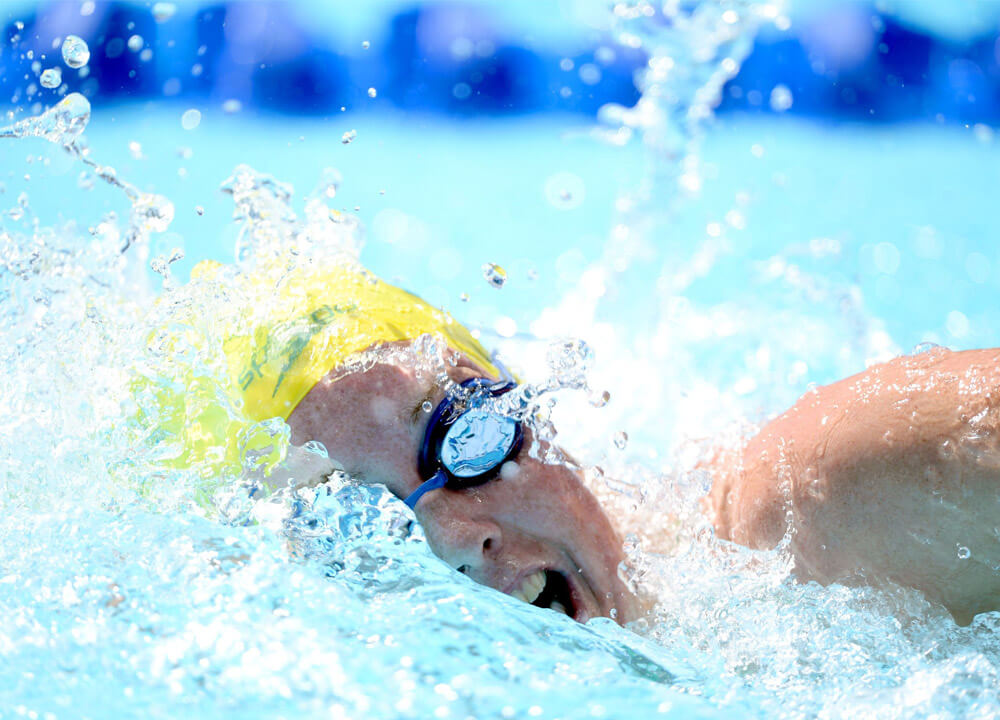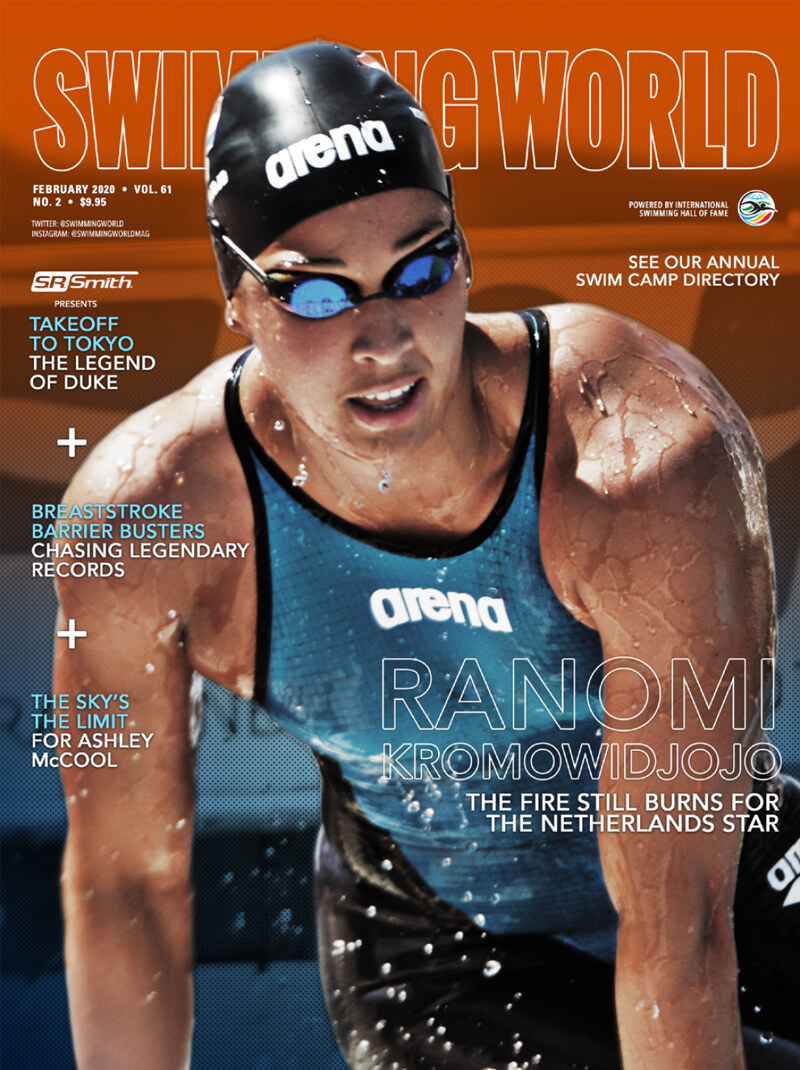Swimming World Presents “Swimming Technique Concepts: Plan For a Breathing Pattern”

Swimming Technique Concepts: Plan For a Breathing Pattern
By Rod Havriluk
Swimmers often use different breathing patterns (i.e., variations in frequency of breathing) based on stroke and distance. Sometimes, a swimmer will maintain a single breathing pattern for an entire swim. At other times, a swimmer will change his/her breathing pattern within a swim. This article encourages swimmers to plan a breathing pattern prior to each swim to gain the most benefit for both racing and training.
Before considering breathing pattern options, a swimmer needs to understand the effect of a breathing motion on his/her perspective of technique. Throughout a non-breathing stroke cycle, the optimal head position is fixed with no vertical, lateral or rotational motion. With a fixed head position, a swimmer’s frame of reference (i.e., his/her perspective of specific technique elements) is constant. With a constant frame of reference, a swimmer can be more certain of the movements of individual body parts.
In three of the strokes, the head position changes to breathe. When the head position changes, the swimmer’s frame of reference also changes. As the frame of reference changes, it becomes more difficult for a swimmer to track and control the movement of body parts. The advantage provided by a constant frame of reference makes a strong case for breathing less frequently.
There are typically training sets where a swimmer can swim slower and limit breathing. During these slower sets, a swimmer can take full advantage of a constant frame of reference to focus on technique. For sets that require faster swimming, a swimmer can use set parameters (the number of repetitions, the distance of each swim, the swimming speed or effort level and the rest interval) to plan a breathing pattern that balances an adequate oxygen supply with a constant frame of reference.
For each swim in a training session or at a swim meet, a swimmer can choose a breathing pattern based on the primary objective of the swim: optimal technique or fast swimming.
To access the full plan for a breathing pattern,
Check out the February issue of Swimming World Magazine, available now!
Get Swimming World Magazine and Swimming World Biweekly FREE When You
Become A Member of the International Swimming Hall of Fame
Want More? Subscribe With This Special 2-Year Offer!
New! 1-Year Digital Only Subscription for just $39.95 Order Now!
Non-Subscribers Can Download This Issue For Only $5.94
017 BREASTSTROKE BARRIER BUSTERS
by David Rieder
The history of the men’s 100 and 200 yard breaststroke has included long stretches of chasing legendary records followed by a shorter period of continuous improvement.
019 LEARNING FROM ADVERSITY
by David Rieder
Minnesota’s Max McHugh was involved in a drive-by shooting last summer, but he believes the incident has left him with a fresh perspective and gratitude for everyday things in his life, including swimming. That approach has fueled his impressive return to the pool.
021 A SENSE OF DÉJÀ VU
by Dan D’Addona and David Rieder
Savannah College of Art and Design (NAIA women), Keiser University (NAIA men) and Indian River State College (NJCAA women and men) appear ready to show the swimming world something it has seen before: repeating as national team champions.
023 THE FIRE INSIDE STILL BURNS
by John Lohn
When discussing the best women’s sprint freestylers heading into this year’s Olympic Games, most frequently mentioned are Australia’s Cate Campbell, Sweden’s Sarah Sjostrom and the USA’s Simone Manuel. But don’t count out triple Olympic champion Ranomi Kromowidjojo of the Netherlands, who feels her best swims are still to come.
025 TAKEOFF TO TOKYO: DUKE
by John Lohn
As Swimming World continues its “Takeoff to Tokyo” series, a century has passed since Duke Kahanamoku last reigned over the water world, but his name—and merely his first name—remains synonymous with greatness in multiple ways.
027 THE SKY IS THE LIMIT
by Dan D’Addona
The future looks bright for junior diver Ashley McCool after transferring to the University of Florida.
COACHING
009 LESSONS WITH THE LEGENDS: CHARLES “RED” SILVIA
by Michael J. Stott
013 SWIMMING TECHNIQUE CONCEPTS: PLAN FOR A BREATHING PATTERN
by Rod Havriluk
Swimmers should plan a breathing pattern prior to each swim to gain the most benefit for both racing and training. The breathing pattern should limit head motion for better focus on technique and also provide sufficient oxygen for better performance.
015 POOR PERFORMANCE… THE NEXT STEP
by Michael J. Stott
At one time or another, disappointment haunts the dreams of even the best swimmers. And often it is the recovery from that disappointment that defines the athlete and, perhaps, the swimmer’s future.
030 SPECIAL SETS: GEORGE HAINES AT WORK
by Michael J. Stott
It never hurts to be a student of the sport. Sometimes that means visiting archival material, be it documents, voices, videos or all of the above to reacquaint ourselves with coaching legends and the methods that made them so effective. Here, Swimming World features the legendary George Haines.
043 Q&A WITH COACH ADAM HOYT
by Michael J. Stott
044 HOW THEY TRAIN ROGER GU AND GRACE GOETCHEUS
by Michael J. Stott
TRAINING
012 DRYSIDE TRAINING: STROKE STRENGTH SERIES—BUTTERFLY
by J.R. Rosania
JUNIOR SWIMMER
040 GOLDMINDS: PARTNERING WITH PARENTS
by Wayne Goldsmith
A simple, but effective strategy for coaches to engage with, connect to and educate the parents of the swimmers on their team is through the development of a “Training Manual for Swimming Parents.”
046 UP & COMERS: ZURI FERGUSON
by Shoshanna Rutemiller
COLUMNS & SPECIAL SECTIONS
007 A VOICE FOR THE SPORT
008 BEYOND THE YARDS
033 2020 SWIM CAMP DIRECTORY
047 GUTTERTALK
048 PARTING SHOT




